- Books Name
- Psychology Book Class-12
- Publication
- PathSet Publications
- Course
- CBSE Class 12
- Subject
- Psychology
Specific Skills
- These skills are core/basic to the field of psychological service. For example,
a) Psychologists working in clinical settings need to be trained in various techniques of:
- Therapeutic interventions
- Psychological assessment
- Counselling
b) Organisational psychologists working in the organisational context need to have:
- Assessment skills
- Facilitation and consultation skills
- Behavioural skills to bring about individual, group, team and organisational development
- Research skills
- Though, specific skills and competencies are required for a very specialised professional functioning, nonetheless, all skill sets do overlap quite a bit. They are not exclusive to an area.
- Relevant specific skills and competencies can be classified as follows:
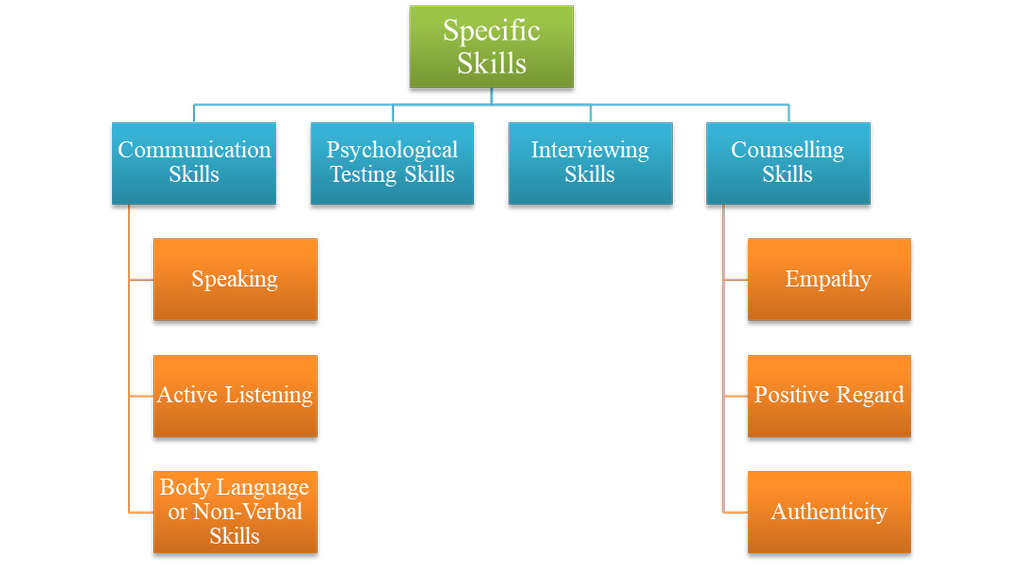
Communication Skills
- It plays an important role in fostering relationships and personal effectiveness.
- Being an effective communicator is one of the most important skills one needs to succeed in life.
- Definition of Communication:
Communication is a conscious or unconscious, intentional or unintentional process in which feelings and ideas are expressed as verbal and/or non-verbal messages that are sent, received, and comprehended.
Characteristics of Communication
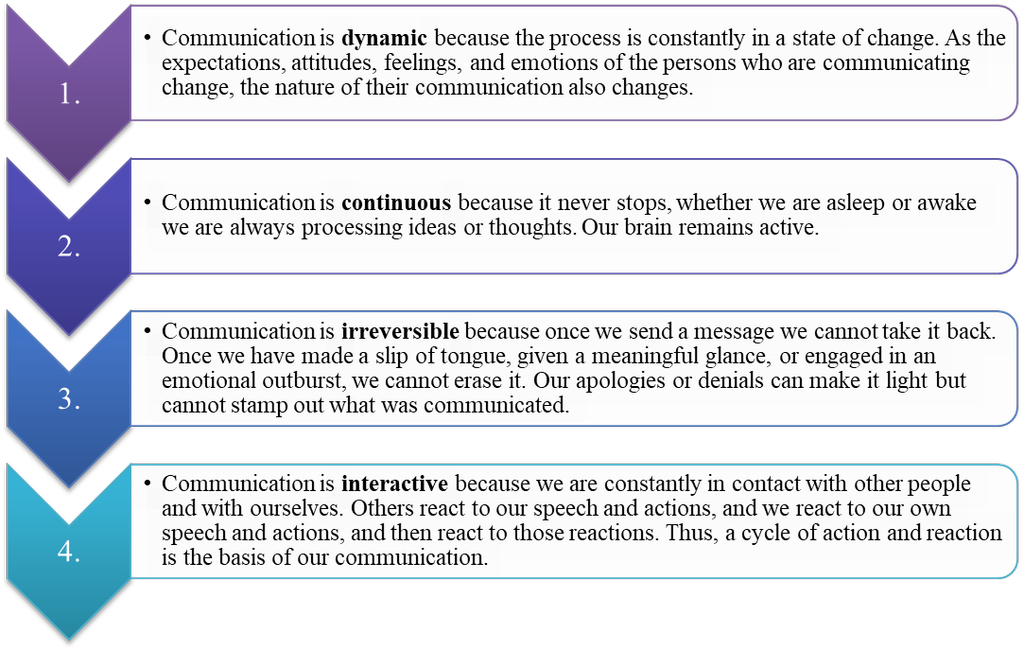
The process of communication can be:
- Accidental (having no intent)
- Expressive (resulting from the emotional state of the person)
- Rhetorical (resulting from the specific goal of the communicator)
Human communication occurs on the following levels:
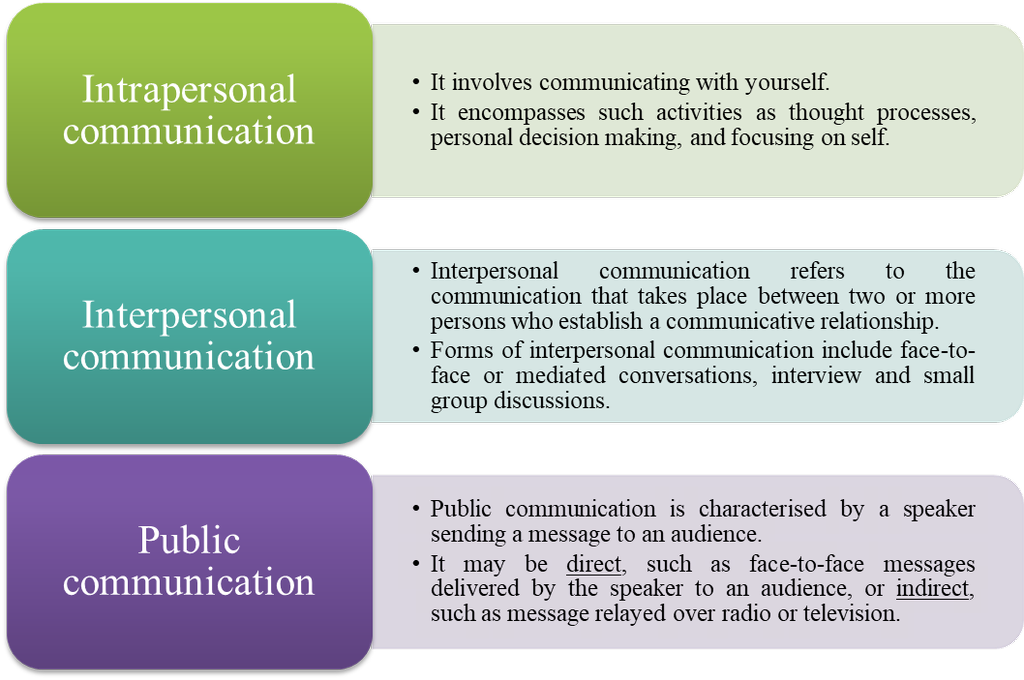
Components of Human Communication
- When we communicate, we communicate selectively, i.e. from the wide range of repertory of words, actions, etc. available to us, we choose that which we believe is best suited for the idea we wish to express.
- When we communicate,
- We encode (i.e., take ideas, give them meaning and put them into message forms) and,
- Send the idea through a channel which is composed of our primary signal system based on our senses (i.e., seeing, hearing, tasting, smelling, and touching).
- The message is sent to someone who receives it using her or his primary signal system.
- She/he decodes (i.e., translates message into understandable forms).
Two major kinds of Communication
- Verbal Communication
For example, one may say that he/she heard a bell or an object feels soft.
These are examples of verbal communication which express how you understand the signals your senses have received.
- Non-Verbal Communication
For example, one touches a hot stove, his/her fingers pull away quickly, and your eyes well up with tears. The pulling away of fingers and welling up of eyes with tears will communicate to an onlooker the pain suffered by the person.
- The following model shows the process of communication involving different stages:
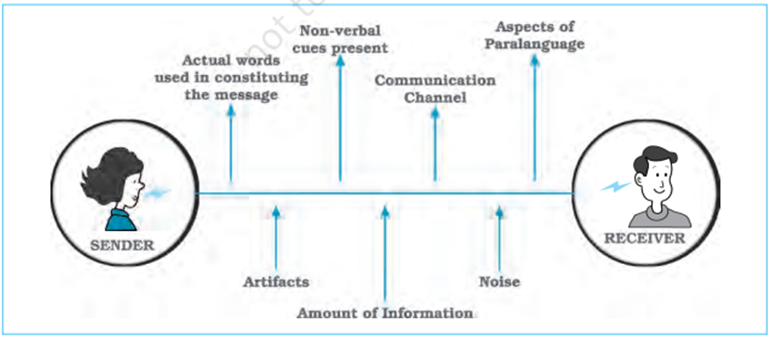
Following influence the communication process:
- Actual words used in constituting the message
- Non-verbal cues present
- Communication channel
- Aspects of Paralanguage
- Artifacts
- Amount of information
- Noise
- The degree to which the communication is effective depends on the communicators’ mutual understanding of the signals or codes being used in transmitting a message and in receiving.
- Difference between Speech and Communication
- Speech is only a biological act; the utterance of sound, possibly the use of language.
- Communication is broader; it involves a relationship among two or more people in which they attempt to share meaning so that the intent of message received is the same as the intent of the message sent.
Speaking
- One of the most important components of communication is speaking with the use of language.
- Language involves use of symbols which package meaning within them.
- To be effective, a communicator must know how to use language appropriately, because language is symbolic, it is necessary to be as clear and precise as possible when using words.
- Communication takes place within a context. So one needs to consider:
- Other’s frame of reference, i.e., the context used by the sender to say something.
- Whether s/he shares your interpretation, if not, it is important to adjust your vocabulary level and choice of words to fit the level of the listener. Slang expressions, words unique to a culture or region, and euphemism can sometimes become obstacles in good communication.
Listening
- It is an important skill that we use daily.
- Academic success, employment achievement, and personal happiness, to a large extent, depend upon one’s ability to listen effectively.
- At first, listening may appear as a passive behaviour, as it involves silence. But this image of passivity is far from true, as listening requires a person to be:
- Attentive,
- Patient,
- Non-judgmental, and
- Yet have the capacity to analyse and respond.
Difference between Listening and Hearing
- Hearing is a biological activity that involves reception of a message through sensory channels. It is only a part of listening.
- Listening is a process that involves reception, attention, assignment of meaning, and listener’s response to the message presented.
- Reception of a stimulus or message
- The initial step in the listening process
- A message could be auditory and/or visual.
- The hearing process is based on a complex set of physical interactions that take place involving the ear and the brain.
- In addition to using the hearing mechanism, people listen through their visual system. They observe a person’s facial expressions, posture, movement, and appearance, which provide important cues that may not be obvious merely by listening to the verbal part of the message.
- Attention
- Once the stimulus, i.e. the word or visual, or both, is received, it reaches the attention stage of the human processing system.
- In this phase, the other stimuli recede so that we can concentrate on specific words or visual symbols.
- Normally, our attention is divided between:
- what we are attempting to listen to
- what is happening around us
- what is going on in our mind
- Thus, our attention is being pulled in different directions.
- Therefore, divided attention makes it difficult for you to receive signals or messages.
- Assignment of Meaning
- The process of putting the stimulus we have received into some predetermined category develops as we acquire language.
- We develop mental categories for interpreting the message we receive.
- Listener’s Response to the Message Presented
Role of Culture in Listening
- The culture, we have been brought up in, influences our listening & learning abilities.
- For example,
- Asian cultures, such as India, emphasise on listening by being a silent communicator when receiving messages from seniors or elders.
- Some cultures focus on controlling attention.
Buddhism, for instance, has a notion called ‘mindfulness’. This means devoting your complete attention to whatever you are doing.
Training in ‘mindfulness’ which starts in childhood can help to develop longer attention spans and therefore, lead not only to better listening but also to sympathetic listening.
- However, in many cultures, such listening enhancing concepts are not present.
Tips to improve Listening skills
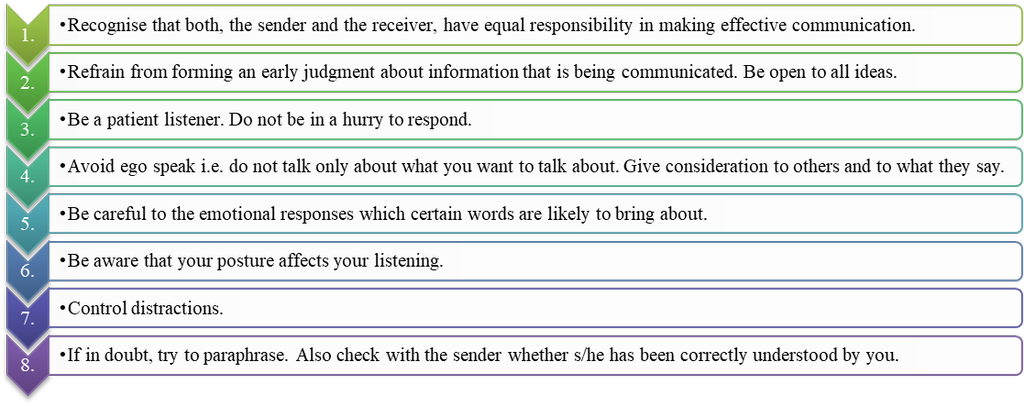
Paraphrasing
- An individual (the receiver) makes a summary of the ideas just received and provides the sender with a restatement of what s/he understands. This is called ‘paraphrasing’.
- The person in doing this does not repeat the exact words said by the sender.
- Paraphrasing allows one to understand how much the other person understood of what was communicated.
- If someone cannot repeat or write down a summary of what was said, then s/he probably did not get the whole message or did not understand it.
Body Language
- When one communicates with another person, his/her words are not enough to communicate the complete meaning of the message.
- It is possible to communicate a great deal even without using verbal language.
- Non-verbal acts are symbolic and closely connected to any talk in progress. Such non-verbal acts are part of what is called ‘body language’.
- Body language is composed of all those messages that people exchange besides words.
- A single non-verbal signal does not carry complete meaning. Factors such as gestures, postures, eye contact, clothing style, and body movement — all of them have to be considered together, that is, in a cluster.
- In verbal communication, non-verbal signs can have many different meanings.
For example, crossing arms over the chest may suggest that a person likes to keep aloof. But, crossed arms accompanied by an erect posture, tightened body muscles, a set clenched jaw, and narrowing of the eyes are likely to communicate anger.
- A person’s background and past patterns of behaviour are also considered when we analyse body language.
- The consistency between current and past patterns of behaviour, as well as harmony between verbal and non-verbal communication, is termed as congruency.
- Body language is used to encourage or discourage conversation. For instance, we consciously wave at waiters or friends to catch their attention.
- Much of the use of body language occurs in conversing with others without conscious realisation.
Psychological Testing Skills
These skills are concerned with the knowledge base of the discipline of psychology.
They involve psychological assessment, evaluation and problem solving with individuals and groups, organisation, and the community.
Psychological tests have been devised and are primarily used for:
- the determination and analysis of individual differences in:
- general intelligence
- differential aptitudes
- educational achievement
- vocational fitness
- personality
- social attitudes
- various non-intellectual characteristics
- studying a variety of psychological studies on groups
- making an assessment of a particular individual
Psychologists study these differences based on factors such as occupation, age, gender, education, culture, etc.
An attitude of objectivity, scientific orientation, and standardised interpretation must be kept in mind while using psychological tests.
Psychological assessment is a basic competency required by psychologists.
It includes knowledge of comprehensive and integrated assessment of persons based on interviewing, psychological testing, and evaluation of the outcomes of psychological services.
The skills needed for psychological assessment are:
- Ability to select and implement multiple methods and means of evaluation in ways that are responsive to, and respectful of diverse individuals, couples, families, and groups.
- Ability to utilise systematic approaches to gather data required for taking decisions.
- Knowledge of psychometric issues and bases of assessment methods.
- Knowledge of issues related to integration of different data sources.
- Ability to integrate assessment data from different sources for diagnostic purposes.
- Ability to formulate and apply diagnoses; to understand strengths and limitations of current diagnostic approaches.
- Capacity for effective use of supervision to implement and enhance skills.
The facts required for psychological assessment are as follows:
- Purpose of the test, i.e. what it has to be used for?
- Target population for which it can be used.
- Type of validation done on the test, i.e. on what basis it can be said that it measures what it claims to measure?
- The external criteria of validation, i.e. the areas in which it has been found working.
- The reliability indices, i.e. how much error is possible in scores?
- The standardisation sample i.e. when the test was constructed, who were tested, e.g. Indians or Americans, rural/urban, literate/semi-literate, etc.?
- Time taken in the administration of test.
- Scoring patterns, i.e. what is to be scored and what method is to be used?
- Norms i.e. what kinds are available? What is the appropriate group which is to be used for interpretation of scores, e.g. male/female, age groups, etc.?
- Influence of any special factors, e.g. presence of others, stress situations, etc.
- Limitations of the test, i.e. who, and what it cannot assess? Conditions in which it may not give good assessment.

 PathSet Publications
PathSet Publications
